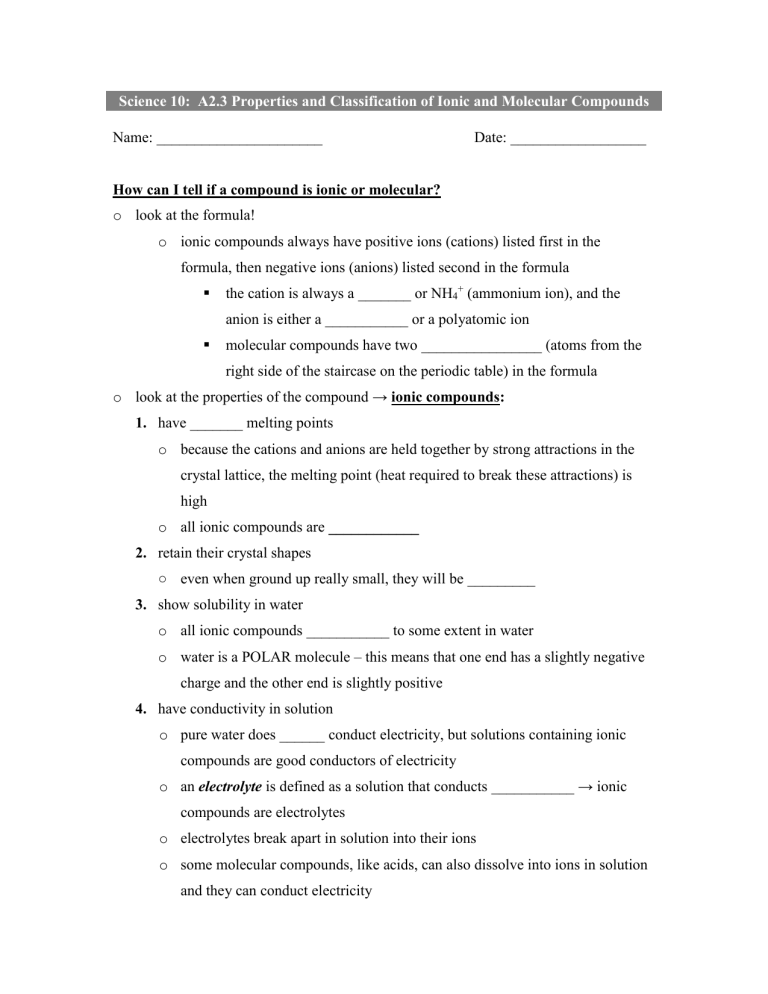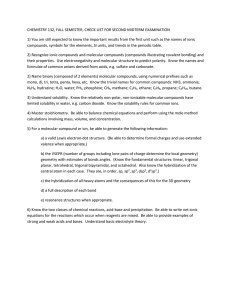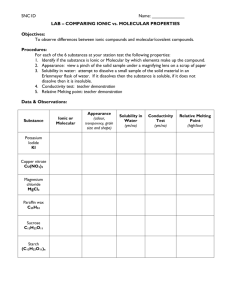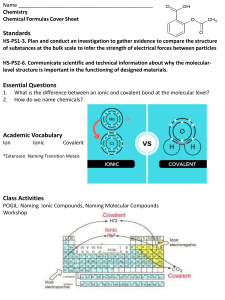
Science 10: A2.3 Properties and Classification of Ionic and Molecular Compounds Name: ______________________ Date: __________________ How can I tell if a compound is ionic or molecular? o look at the formula! o ionic compounds always have positive ions (cations) listed first in the formula, then negative ions (anions) listed second in the formula the cation is always a _______ or NH4+ (ammonium ion), and the anion is either a ___________ or a polyatomic ion molecular compounds have two ________________ (atoms from the right side of the staircase on the periodic table) in the formula o look at the properties of the compound → ionic compounds: 1. have _______ melting points o because the cations and anions are held together by strong attractions in the crystal lattice, the melting point (heat required to break these attractions) is high o all ionic compounds are ____________ 2. retain their crystal shapes ○ even when ground up really small, they will be _________ 3. show solubility in water o all ionic compounds ___________ to some extent in water o water is a POLAR molecule – this means that one end has a slightly negative charge and the other end is slightly positive 4. have conductivity in solution o pure water does ______ conduct electricity, but solutions containing ionic compounds are good conductors of electricity o an electrolyte is defined as a solution that conducts ___________ → ionic compounds are electrolytes o electrolytes break apart in solution into their ions o some molecular compounds, like acids, can also dissolve into ions in solution and they can conduct electricity Solubility of Ionic Compounds o some ionic compounds dissolve better than others — a substance that dissolves well is called soluble o to indicate that a substance is soluble, we use the subscript “______” after the formula → “(aq)” stands for “__________” (watery) o if a substance does not dissolve in water, it is said to have low solubility o a low solubility compound can form a cloudy solution, or a big clump of sediment will form at the bottom of the container → this is called a “_____________” o low solubility compounds are indicated by the subscript “(s)” after the formula o how do you know if a solution is (aq) or (s) ???? o on the back of your data sheet is a solubility chart that looks like this: Solubility of Some Common Ionic Compounds in Water Note: Group 1 = Li+, Na+, K+, Rb+, Cs+, Fr+ “most” means “most compounds containing these ions” Ion Solubility greater than or equal to 0.1 mol/L (very soluble) Solubility less than 0.1 mol/L (slightly soluble) Group 1 ions NH4+ NO3− ClO3− ClO4− CH3COO− F− Cl− Br− I− 2− SO4 PO43− SO32− CO32− Group 1 ions most most most most NH4+ RbClO4 CsClO4 AgCH3COO Hg2(CH3COO)2 Li+ Mg2+ Ca2+ Sr2+ Ba2+ Fe2+ Hg22+ Pb2+ + Cu Ag+ Hg22+ Pb2+ Tl+ Ca2+ Sr2+ Ba2+ Ag+ Hg22+ Pb2+ Ra2+ most IO3− OOCCOO2− OH− Group 1 ions NH4+ Co(IO3)2 Fe(OOCCOO)3 Group 1 ions NH4+ Sr2+ most most o let’s use NaOH as our example 1. find the negative ion (OH–) at the top of the table 2. look underneath it for the positive ion (Na+) or the group that the cation is in (hint: Na+ is in group 1) 3. if the positive ion is in the “very soluble” row (look to the left of the chart to find this word), then the compound is aqueous (aq) 4. if the positive ion is in the “slightly soluble” row, then the compound is solid (s) and it is a precipitate So, what is sodium hydroxide? _______________ Try some! Silver iodide _______________ CaSO4 _______________ Ammonium phosphate _______________ Iron(III) sulfate _______________ Ba(OH)2 _______________ Properties of Molecular Compounds 1. _______ melting points o molecular compounds are made up of molecules, which are two or more nonmetals held together by covalent bonds o covalent bonds are very strong bonds formed when the non-metals share electrons o while the attraction between individual atoms in a molecule is very strong, the attraction between neighboring molecules is weak, so not much energy is required to break the attraction as a result, molecular compounds have lower ____________ points than ionic compounds 2. crystals do not maintain their shape — they crumble easily 3. most molecular compounds are _______ soluble in water, but some are! o “like dissolves like” – many molecular compounds are non-polar so they dissolve in other non-polar molecules such as gasoline or oil 4. low or no conductivity in solution o molecules are electrically neutral, and do NOT break up into ions in solution (with the exception of ACIDS), so molecular compounds DO NOT conduct electricity → they are non-electrolytes let’s summarize what we know so far: Ionic Compounds Molecular compounds Melting point Crystal shape Solubility in water Conductivity Electrolyte or not Special Properties of Water A water molecule o water is a ___________ molecule – one end is negative, and the other is positive o this is due to the bent shape of water and because of unequal sharing of the electrons in the molecule o this means that water molecules will ___________ one another → the positive end of one molecule is attracted to the negative end of the second molecule o water has a much higher boiling point (100°C) because of its polarity o liquid water forms ice, and its molecules spread out to make six-sided rings o liquid water is _________________ than ice (otherwise ice would not be able to float on top of water) Practice Problems Use the solubility chart (table) on your data sheet to complete the following. 3. Explain how to recognize an ionic compound from its chemical formula. 4. Describe four properties of an ionic compound. 5. Explain how to recognize a molecular compound by its chemical formula. 6. Describe four properties of molecular compounds. 7. Water is a polar molecule. What does this mean? 8. Use your solubility table to determine if each of the following compounds is slightly soluble (s) or very soluble (aq). a) NaCl d) BaSO4 b) PbCl2 e) CsCH3COO c) PbCl4 f) K2CO3 9. Fill in the following chart. Compound Molecular or Ionic 1 2 3 Properties Melting point 48°C, low solubility in water, flammable, mild odour, colourless solid, easily crushed Melting point: 800°C, highly soluble, solution is highly conductive, hard, white crystals Highly flammable liquid at room temperature, does not mix with water, less dense than water Explanation



